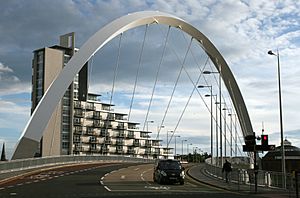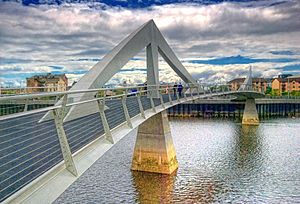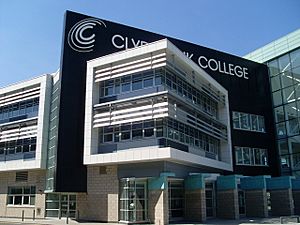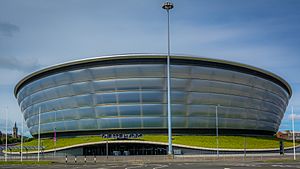Clyde Waterfront Regeneration facts for kids

The Clyde Waterfront Regeneration was a big project in Scotland. It started in 2003 and finished in 2014. The project aimed to make the area along the River Clyde much better. This river runs through Glasgow, from Glasgow Green all the way to Dumbarton.
Many different groups worked together on this project. They wanted to improve businesses, homes, tourism, and transport. Billions of pounds were planned to be spent to make these changes happen.
The main goal was to transform the waterfront area of Glasgow. This included building new places and improving old ones.
Some key parts of the project were:
- New buildings: Many new buildings were constructed. These included offices, homes, and hotels. Famous new places like the Riverside Museum, the OVO Hydro arena, and the Glasgow Science Centre were part of this.
- Public spaces: The project created more open areas for everyone to enjoy. These included parks, walking paths, and cycle routes along the river.
- Better transport: Roads, bridges, and public transport links were improved. The Clyde Arc, also called the Squinty Bridge, was built. It helps people walk and cycle across the river.
The Clyde Waterfront project was a team effort. Glasgow City Council and Scottish Enterprise worked with many other partners. It helped the area grow economically. It also brought a lot of money from both public and private groups.
The project aimed to help local people too. It was hoped that new transport and fun places would benefit them. More shops and businesses would open. This would also create many new jobs. Around 50,000 new jobs were expected. Training was also offered to help people get these new jobs.
Contents
Cool Projects Along the Clyde
New Homes and Businesses

In Glasgow city centre, a special area called the International Financial Services District (IFSD) was created. It brought many new financial companies to the city. This area was a partnership between Scottish Enterprise and Glasgow City Council. It created lots of new office space. Since 2001, over 15,000 new jobs have appeared here. Over £1 billion has been invested.
New business parks are growing. The town of Renfrew is also getting a makeover. Many home builders are creating 2,000 new homes at Ferry Village. This is near the Xscape leisure centre.
Glasgow's Digital Media Quarter is at Pacific Quay. It is now home to the main offices of BBC Scotland. It has three large TV studios. One of them, "Studio A", is the biggest TV studio outside London. Other buildings nearby also help Scotland's digital media companies.
On the north side of the river, a huge housing project called Glasgow Harbour is almost finished. The second part, GH20, will add 800 more apartments. Many of these are already sold.
Further down the river in Clydebank, students at Clydebank College moved into new buildings in 2007. These buildings overlook the river. Forty years ago, the John Brown Shipyard built the famous QE2 ship here. Now, this area, called Queens Quay, has a college campus and a business park.
Better Ways to Travel
Good transport is very important to connect the whole area. Many big projects were completed. For example, the Clyde Arc, also known as the "Squinty Bridge", was opened. It was the first new road bridge across the Clyde in Glasgow in almost 40 years. This bridge connects the West End of Glasgow to the Digital Media Quarter at Pacific Quay and then to Govan.
A bridge just for walkers, called the Tradeston Bridge, opened in 2009. It links Glasgow's IFSD on the north side to new developments on the south side at Tradeston.
Renfrewshire Council is planning a new road bridge. It would connect Renfrew and Yoker. This new bridge might replace the Renfrew Ferry service. The Clyde is still used by ships, so the new bridge would need to be able to move. This would let vessels pass up and down the river. The bridge could cost around £50 million. If approved, building could start around 2018-2019.
Fun and Culture
Glasgow was chosen to host the 2014 Commonwealth Games. This led to even more developments. A new arena, Scotland's National Arena, was built at the SECC. It has 12,500 seats. This arena helps create jobs and brings many visitors to the city. More hotels were also needed for the expected increase in tourists. Key transport projects were finished in time for the Games.
Work on the Riverside Museum project finished in 2011. The famous architect Zaha Hadid designed this amazing building. It now holds Glasgow's transport collection.
More Clyde Waterfront Projects
-
The fantastic Riverside Museum
-
The Braehead shopping centre
-
Boden Boo nature reserve at Erskine











